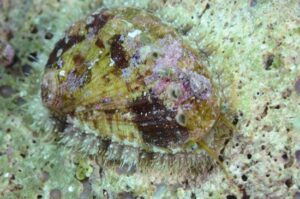Crown of Thorns Starfish, COTS for short, Acanthaster planci in Latin, are coral-eating starfish. One of the largest in the world, they can reach up to 70cm in size and 3kg in weight but, on average, 30cm in diameter.
They are mainly found in Indo-Pacific regions and are widely spread around Australia and the Red Sea. Depending on where they live, you can find them in different colours: purple, red, grey or brown, with varying spine colours. Like other starfish, they have multiple arms, 16 to 21, that can regenerate when lost. They are thought to regenerate into two perfectly functioning individuals if cut in half.
The animal’s upper surface has long spines coated with highly toxic venom. It is these long spines that form the “crown of thorns”.
They move slowly, around 20m a day, but they are one of the very few species of starfish that seem to actively hunt for food.
Their reproduction is impressive; one female can release up to 100 million gametes at once; however, most larvae don’t survive to adulthood. The larvae drift in the water column for around 10 days before settling on the seabed.
When they are juveniles, they feed on algae for the first 6 months and stay in deeper areas of the reef. Once bigger than 10mm, they start moving upwards to the top of the reef. Usually nocturnal, they feed on corals when they’re adults by extruding their stomach out of their mouth, spreading it over the surface of the corals and releasing digestive enzymes which liquefy and absorb the coral tissues. They leave bare coral skeletons on the reefs and, if not kept in check, can cause serious damage to them.
Many very unusual population explosions, called COTS infestations or outbreaks, have been happening in recent years, devastatingly affecting coral reefs around the Indo-Pacific. In contrast, they are usually a part of a healthy reef, maintaining high coral diversity by eating mainly polyps of fast-growing corals, of which the starfish can eat up to 12m2 per day.
When conditions are favourable, the population can increase to very high numbers, with several hundred per meter. They destroy all the corals on the reef, leaving just the skeleton. Recovery from COTS can take up to a few decades. It is unknown what the exact cause of the population explosion is, but overfishing of their natural predators could be a reason. They spawn when stressed, so possibly water quality deterioration could contribute to increased spawning. Increased sea temperatures and nutrient content could also be contributors to the outbreaks.
The sting of the starfish can be very painful, and these outbreaks concern the tourism and diving industry. Management of outbreaks involves manual removal of starfish and disposal ashore, which is labour-intensive. Also, it is debatable how successful this method is. Some other more controversial forms of removal, including chemical injections, have been tried, but mostly environmentally friendly alternatives, such as vinegar or natural acidic products, are currently being trialled.
Written by Bogna Grifin, Marine Biologist
For diving with Crown of Thorns Starfish, see Koh Tao Divers.
Photos by Ivana Orlovic Kranjc and Janez Kranjc
The post The Crown of Thorns Starfish – To admire from a safe distance appeared first on Mares – Scuba Diving Blog.
Read MoreDiving, crown of thorns, dive center, Koh Tao, marine life, rebreather, Sidemount, SSI, starfish, Thailand, XRMares – Scuba Diving Blog


